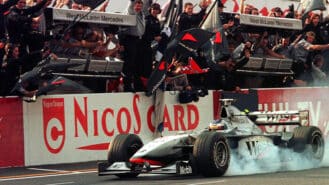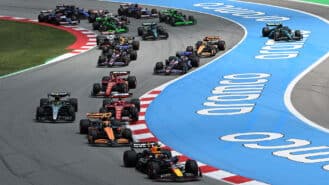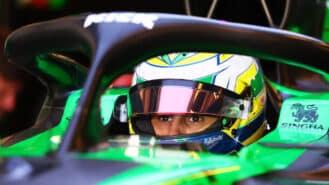A series taken from the 164-page Motor Sport special Great Racing Cars, which is available to buy here

To buy the lead image click here.
From the editor Damien Smith
How would you define a ‘great’ racing car? Race wins and championship titles are an obvious place to start – and admittedly, when we began the process of rounding up the ‘voices’ to fill this special magazine, published by the team behind Motor Sport, we had in mind the likes of the Lotus 72, Ferrari F2004, Porsche 917, Audi R10 and so on.
But as the interviews of familiar racing figures began, we realised greatness is often a very personal thing. Naturally, most – but not all – would pick cars they had experienced first-hand, as a driver, designer, engineer or team boss. And on occasion the cars that stood out in their minds as ‘great’ weren’t necessarily so in the grand scheme of history. That’s why you’ll find a Minardi here among Formula 1 cars from Lotus, Williams and McLaren.
Unexpected? Certainly. Wrong? Not to the man who chose it.
As the interviews accumulated, our magazine took on a life of its own, full of personal anecdotes about the myriad cars that made careers. Some of those we spoke to, such as Mario Andretti and Dan Gurney, couldn’t be tied to a single choice from multi-faceted lives at the wheel. Such heroes have earned the right to choose an F1, sports and Indycar, so we allowed them more than one bite.
Others refused to be confined by category. Hence the short ‘Odd ’n Sods’ chapter on cars that, by and large, are mere footnotes in lower divisions of racing lore.
Thus there is nothing definitive about the selection listed herein. Then again, there’s no claim that this compilation offers the ‘Greatest Racing Cars’ of history. It’s much more personal than that, much more quirky – and all the better for it.

1938-39 Mercedes-Benz W154


Mike Blanchet
Veteran engineer
The Silver Arrows Mercedes W154, at least the last three-litre V12 supercharged one, was so elemental with that great long bonnet and a massive steering wheel, that it has to be one of the greatest racing cars. It was a real brute, but sophisticated with it. I think this is what racing cars should look like, so exciting, and it must have made one hell of a spectacle.
There is a good argument for stating that it was one of the first racing cars that was thought about scientifically. Before that it was pretty seat-of-the-pants and all a bit artisan. Mercedes really looked in to things like roll centres and cambers when they designed the car and they went in to great details and every aspect to come up with this extraordinary machine.
Driving those things around the Nordschleife must have been so exciting and hairy. The drivers had to have incredible brawn to get the best out of them. Of course you had to drive them within their own limits, but there was so much skill and energy needed just to keep those things on the track. And remember that the races then were usually three hours at least.
I think it was telling that Rudi Uhlenhaut was one of the designers on the W154. First and foremost he was an engineer, but by all accounts was as good if not better at driving than some of the regular pilots. But of course Rudolf Caracciola was the man, wasn’t he? Although Dick Seaman scored some good results, especially the win at the Nürburgring in 1938.
I count myself lucky to have seen some of these cars at Goodwood and so forth. Quite what they were like to see in period, raced by those heroes, is something I can only dream about.


Remembering Donington in 1938
Motor Sport’s long-time editor Bill Boddy recalls the day the W154 and the Auto Unions conquered Britain
In 1938 Mercedes-Benz had von Brauchitsch, Seaman, Lang and Bäumer as drivers, Auto Union fielding Nuvolari, Müller, Hasse and Kautz in their oversteering rear-engined V12 cars. The W154 Mercedes-Benz also had a V12, of three litres to comply with the GP rules. It was an electric occasion, the race started by the Duke of Kent, the BRDC President in Chief, German Embassy staff arriving in open Mercedes-Benzes and BMWs and Hitler’s Reichsleiter Hühnlein present. Hühnlein was given a few laps in Lionel Martin’s Bentley, while the Duke, after flying up from London, had some quick ones in a V12 Lagonda driven by Seaman.
Like Schumacher, Nuvolari had asked how much more of the last practice session remained, then, with minutes to spare, rotated a finger to tell his mechanic to start the Auto Union and went out to try for pole position. But Lang had gone 0.2sec quicker.
The flag fell and they got away in a crash of sound, and the almondy boot-polish aroma of burnt racing fuel hung under the trees. One lap gone and Nuvolari led, ahead of Müller, Brauchitsch, Seaman, Lang and Bäumer. Along the straight speeds rose to 170mph. Kautz’s throttle struck open and he hit a bank and was out after two laps. Ten laps run and Nuvolari had 14.6sec on his team-mate and Seaman had passed von Brauchitsch. At 26 laps Nuvolari came in to change a plug, dropping him to fourth, Müller still leading and Lang picking off the ERAs as if they were London taxis.
Then drama! Hanson’s Alta blew its engine, shedding oil. Nuvolari, foreseeing this, slid sideways onto the grass, bare arms putting the steering from lock to lock, and kept on. Von Brauchitsch spun twice but recovered. Hasse really lost it and hit the bank. Seaman went off and push-restarted; Lang and Müller slid but kept going. Drama again, as Bäumer had all the wheels changed and fuel put in, to leave after 35sec, against Lang’s earlier stop of 33sec. With 30 laps to run, Muller led Lang by 21sec, Nuvolari by 79sec. But, as expected, Tazio gave all he had. Making fastest lap at 83.71mph with 17 more to do, he closed on Lang, whom he took on lap 67, to win the race at 80.49mph after 3hr 6min 22sec of hard work. Seaman was third, a lap behind.
As John Eason-Gibson drove me back to London in his Opel Kadett, we had much to discuss.
Taken from the June 1999 issue of Motor Sport. To read more click here.








